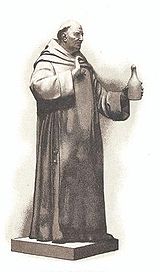Dom Pérignon
Pierre Pérignon, called Dom Pérignon OSB (* around 1638 in Sainte-Menehould , † September 14, 1715 in Hautvillers , Champagne ), was a French monk of the Benedictine order . He was instrumental in developing the Méthode champenoise , a method of bottle fermentation for the production of sparkling wine , but according to the prevailing opinion, he did not invent it. The Dom Pérignon champagne brand from Moët & Chandon is named after him.
In 1668, Dom Pérignon, as cellarer, became the brother of the Hautvillers Abbey responsible for the economic supply of the monastery . Since the wine production was one of the main sources of income of this monastery, it came under his supervision. Together with the cellar master of the Abbey of Saint-Pierre aux Monts de Châlons, brother Jean Oudart (1654–1742), he further developed the oenological methods of the time. He found that the quality of the wine increased significantly by blending different grape varieties. He also closed the bottles with a cork that was secured to the neck of the bottle with cords (the first clasp ). He also used thick-walled bottles that could withstand high internal pressure. He used chalk caves near the monastery for storage. He also found that it was beneficial for the intensity of a wine to limit the yield. Posterity owes its knowledge of the importance and art of assemblage and white wine pressing ( Blanc de Noirs ) to him.
The widespread bottle filling volume of 0.7 liters can also be traced back to Dom Pérignon, which he determined to be the average amount consumed by male adults at dinner.
Brother Jean Oudart continued to develop the cellar technology even after Dom Pérignon's death.
Web links
| personal data | |
|---|---|
| SURNAME | Perignon, Dom |
| ALTERNATIVE NAMES | Perignon, Pierre |
| BRIEF DESCRIPTION | French Benedictine monk and cellar master |
| DATE OF BIRTH | around 1638 |
| PLACE OF BIRTH | Sainte-Menehould |
| DATE OF DEATH | September 14, 1715 |
| Place of death | Hautvillers , Champagne |
